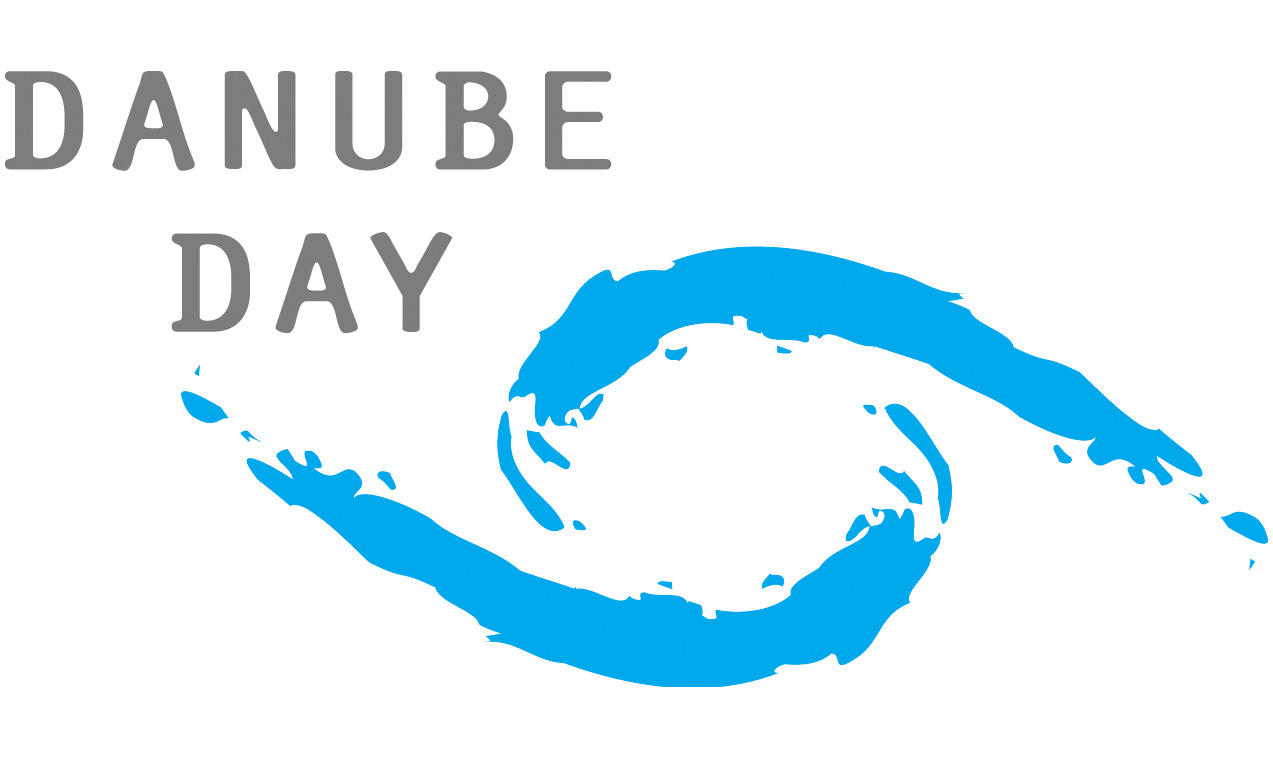Providing safe passage routes on the Columbia River

Providing safe passage routes on the Columbia River
The Pacific salmon faces many of the same obstacles as the Danube’s Huchen in reaching safe spawning grounds. However, hydropower planning that has included fish passages from the very beginning has made passage survival a reality.
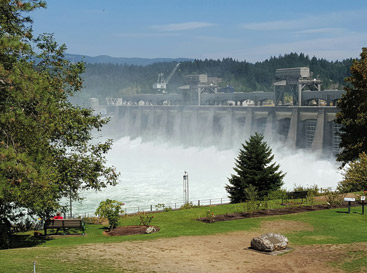
Spilling water and fish over dams and thus away from turbines is generally the safest method of the juvenile fish passage routes at the Columbia and Snake River dams.
© Harrison/NPCC
In the Pacific Northwest, a region of about 15 million people, the Pacific salmon has cultural, sustenance and environmental importance. In his 1990 book The Good Rain: Across Time and Terrain in the Pacific Northwest, author Timothy Egan writes, “The Pacific Northwest is simply this: wherever the salmon can get to.”
However, like the Huchen, the iconic signature fish of the Danube Basin, Pacific salmon migrate in rivers where hydropower dams threaten their survival. Hydropower is the largest source of electricity in the area and nearly half of the region’s hydropower is generated at dams in the Columbia River Basin, with most of that generated at the 31 dams of the Federal Columbia River Power System.
The Columbia Basin covers 671,000 square kilometers and has an annual discharge of 237 billion cubic meters. Adult salmon and steelhead can travel up the Columbia River past dams for about 877 kilometers, and up the Columbia’s major tributary, the Snake River, for about 920 kilometers. Passage facilities for both adult and juvenile fish have been in place for decades at many – though not all – hydropower dams in the region. Over time, passage survival has improved as research, monitoring and evaluation has informed decisions about new passage facilities, modifications of existing structures and river operations.
The first of its kind. A guiding principle for new hydropower dams in the Danube Basin is to ensure fish migration, and the same was true when Bonneville Lock and Dam, the first Columbia dam inland from the ocean, was completed in 1938. At more than 21 meters tall, Bonneville was the largest fish-blocking structure built on any river in the United States or Europe at the time, and provided access to spawning grounds for more than 75% of all migratory fish in the Columbia Basin.
There was strong political, scientific, and public support for the fish passage at Bonneville Dam. For adult fish, the original construction included fish ladders, hydraulic fish lifts (though these proved ineffective and later were abandoned), a fish-collection system across the front of the dam, and bypasses. Attracted to the outflow of the ladders, adult fish find the entrances, navigate the ladders and passages, and exit behind the dam.
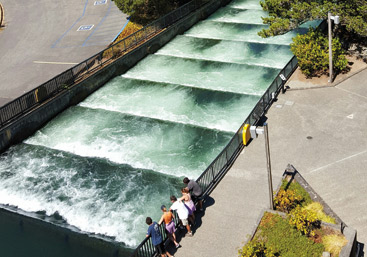
Bonneville Dam provides access to spawning ground for more than 75% of all migratory fish in the Columbia Basin.
© Harrison/NPCC
Downstream challenges. Passing juvenile fish downstream, however, has proven more problematic – an issue for many European rivers as well. With the exception of some steelhead, there is no downstream migration of adult anadromous salmonids in the Columbia River. In the 1930s, it was believed juvenile salmonids could survive passage through hydropower turbines, but over time it became apparent that passage through the high-pressure turbine environment was more lethal than earlier believed. In addition, slow-moving water in reservoirs delayed the physiologically important migration to saltwater.
Fish encountered these problems at all of the dams where passage was provided. Research revealed where and how fish approached the dams, passed through them, and whether they survived. This has led to ongoing improvements in passage facilities and river operations to assist passage.
In addition to dam passage, other factors affect survival (predation, harvest, straying, injuries or disease). While juvenile passage survival at Bonneville Dam is about 96%, survival declines as a function of how many dams fish must pass. In 2014, for example, estimated juvenile survival through the eight dams of the lower Snake and Columbia rivers was 49.7% for Snake River yearling Chinook salmon and 77.1% for Snake River steelhead. For the 2008-2012 period, the average adult passage survival upstream past the same eight dams ranged from 70.9% to 97%, depending on the species.
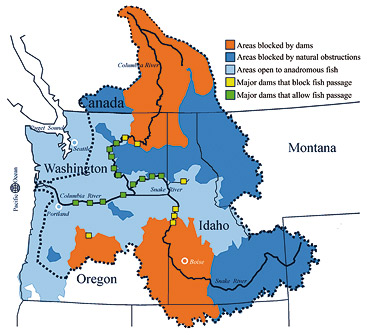
Adult salmon and steelhead can travel up the Columbia River past dams for about 877 kilometers, and up the Columbia’s major tributary, the Snake River, for about 920 kilometers
© Northwest Power and Conservation Council
Increasing passage survival for the future. Although newer small dams are possible, it is unlikely that additional large dams will be built in the Columbia River Basin. Some 71,000 kilometers of streams and rivers in the Columbia Basin are protected from hydroelectric development in order to prevent major negative impacts that could not be reversed.
However, hydropower will continue to be the major source of electricity in the Pacific Northwest, and salmon and steelhead will continue to be the most important fish species in the region. In 2014, more than 2.5 million adult salmonids were counted at Bonneville Dam, a record since counting began there in 1938. While the record is good news demonstrating that fish clearly are passing dams successfully in the Columbia River Basin, there is more work to do. Fishery managers and dam operators will continue to look for ways to increase dam-passage survival.
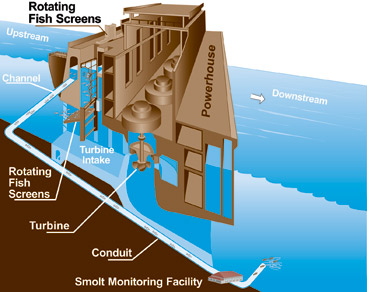
Juvenile Bypass Schematic
Today, juvenile fish passage routes at the mainstem Columbia and Snake River dams include:
Spill:
Spilling water and fish over dams and thus away from turbines is generally the safest method
Surface passage:
Specially designed spillway weirs take advantage of natural migration patterns – juvenile salmonids tend to migrate in the top 3-9 meters of the water column
Screened bypass systems:
These facilities guide fish away from turbines and into bypass channels by means of submerged screens installed in front of turbine intakes
Barging:
When river conditions are poor – warm water, low flow – fish are collected from bypass system outfalls and transported downriver past the dams in specially designed barges



